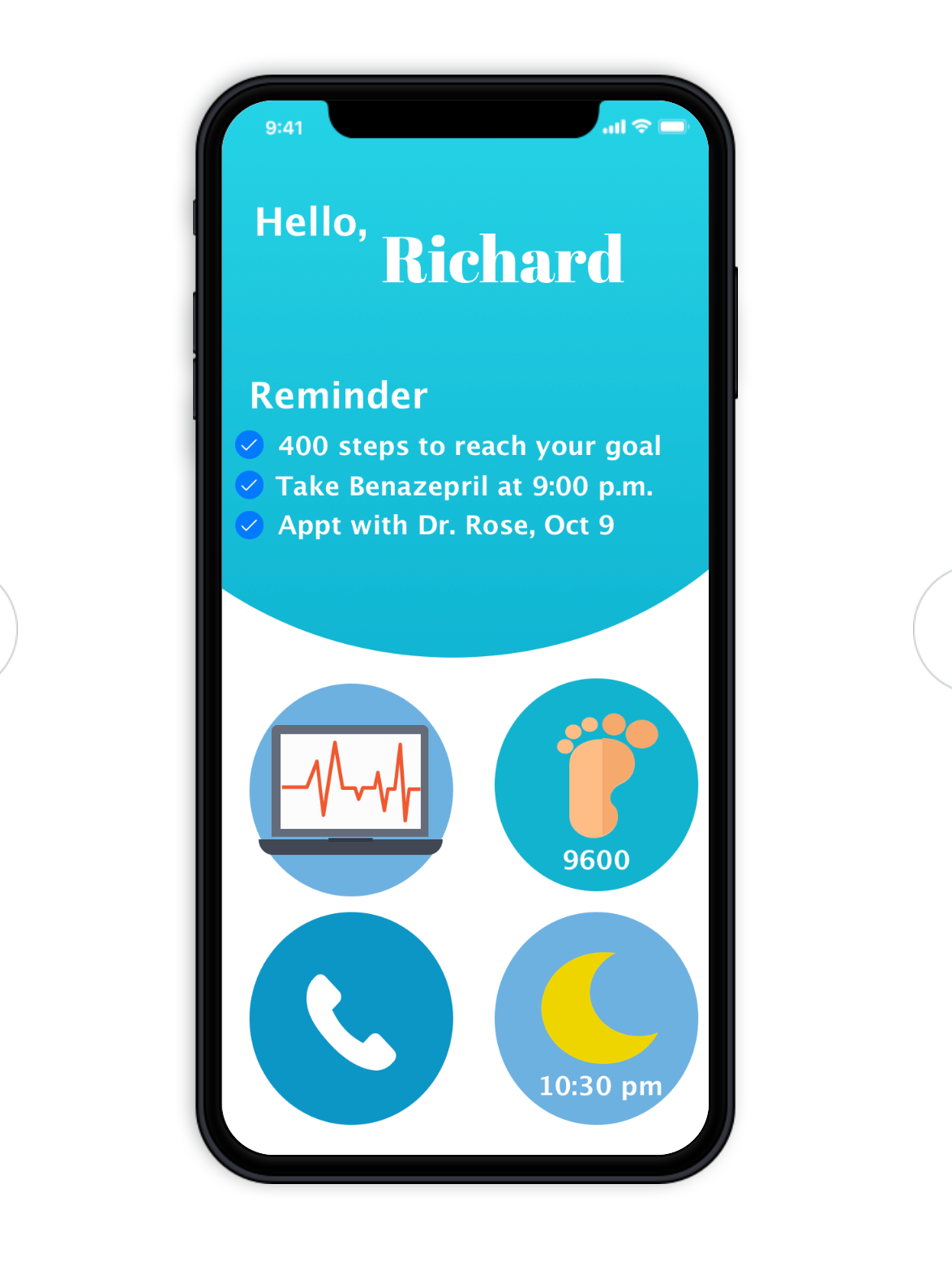SUMMARY
We collaborated with Department of Family and Child Nursing at University of Washington for designing children asthma tracker/monitor.
Project Member: Courtney McKee, Mulki Mohamed.
Duration: 2 months
Skills: Interview, Participatory, comic-boarding with children
Tools: Figma, Sketch
BACKGROUND
According to the Asthma and Allergy Foundation of America, 1 in 12 children had asthma (in 2017), which is considered as the leading chronic disease in children. Although asthma is not curable, it can be preventable. There are early signs before the asthma attack. Thus, many people can take some preventable measure after being aware of the early symptoms, such as taking asthma treatments.
According to the Asthma and Allergy Foundation of America, 1 in 12 children had asthma (in 2017), which is considered as the leading chronic disease in children. Although asthma is not curable, it can be preventable. There are early signs before the asthma attack. Thus, many people can take some preventable measure after being aware of the early symptoms, such as taking asthma treatments.
PROBLEM
Children hate asthma inhaler, and they often forget (intentionally or accidentally) about taking their asthma medications. Also, they often lie to their parents about their asthma symptoms, fearing that their parents may restrict their activities, such as soccer practice or sleepover.
Children hate asthma inhaler, and they often forget (intentionally or accidentally) about taking their asthma medications. Also, they often lie to their parents about their asthma symptoms, fearing that their parents may restrict their activities, such as soccer practice or sleepover.
GOAL
Finding a solution that supports children with asthma, which make children independent of taking medications and also report to the parents with honesty.
Finding a solution that supports children with asthma, which make children independent of taking medications and also report to the parents with honesty.
DESIGN PROCESS
Sponsor Meeting->
Watch previous studies ->
Literature Review + Competitive Analysis ->
Form Design Requirement ->
Interview Parents + Participatory Design with Children ->
Individual Ideate ->
Group Prototype ->
Concept Testing
Sponsor Meeting->
Watch previous studies ->
Literature Review + Competitive Analysis ->
Form Design Requirement ->
Interview Parents + Participatory Design with Children ->
Individual Ideate ->
Group Prototype ->
Concept Testing
RESEARCH PARTICIPANTS
We focused on children with the age of 6 to 11 despite that we
knew that the age is dispersed into two distinct groups. By the
age of 6, children start to go to elementary schools where the
parents would not be able to be aware of the children’s situations
as much. Then, children have to report their asthma situations to
their parents.
We focused on children with the age of 6 to 11 despite that we
knew that the age is dispersed into two distinct groups. By the
age of 6, children start to go to elementary schools where the
parents would not be able to be aware of the children’s situations
as much. Then, children have to report their asthma situations to
their parents.
Video Caption of previous Kids Study
A 7 years-old boy mentioned that he fell and had a concussion. He did not tell his parents straight away, and hid his pain because he wanted to keep play the soccer practice.
“I did not know the consequences... I would not lie if I know.”
A 8 years-old girl talked about her experience of scapegoating her cousin breaking glasses when she broke the glass. Her grandmother asked her twice about the situation, and at the second time, she spoke the truth.
“But when my grandmother asked again, I told her the truth.”
Two key ideas that we incorporated into our design to combat children's dishonesty
1. Knowledge about Asthma so the children know the
risk and the danger
2. Asking twice algorithm so the children are likely
answer with honesty
risk and the danger
2. Asking twice algorithm so the children are likely
answer with honesty
These are the two screens to ask the children whether they have taken their asthma medication incorporating with the asking twice algorithm.
After talking to the children, I realized 7/9 children were very resistant in talking about their asthma situations, and expressed negative emotions, drawing sad faces. Two children even drew about staying home with sad faces. A girl drew her mom as the dragon as she is inspecting her asthma situations.
This is part of a drawing from a 7 years-old girl. She said the dinosaur is her mom and inspecting her asthma condition with her cellphone
Later, we asked the children to design an asthma helper that could support their asthma conditions. Their designs overlapped with wearables (wristband, necklace), stuffed animals, and apps.
This is a drawing made by a 9 years old girl, who drew a vibrating toothbrush (top-left image) that reminds the child to take their asthma medication when they are brushing their tooth. She also drew a necklace with a cross (top-right image) that whenever she does not feel well, which sends to her parents' phone with a long hard press to her necklace is 'emergency', a normal weight press with some duration is 'feeling bad', and a light press is she is 'alright'.
At the end, she concluded her brainstorm with a necklace that she can wear in school. and she can press the number (1 = okay, 2 = bad, 3 = needs to go to hospital) and send it to her parents.
The idea was really great and thoughtful, and we would like to incorporate in the future design after tackling the honesty and awareness issue.
The idea was really great and thoughtful, and we would like to incorporate in the future design after tackling the honesty and awareness issue.
Our design is very complicated that addresses two different but related problems.
We focused on tablet app that can
We focused on tablet app that can
1. Gamify their asthma tracking system
2. Inform them about the asthma background and risks
3. Bridge the communication between the parents and the children without asking the children directly if they have taken the medication
4. Enjoyable and fun
2. Inform them about the asthma background and risks
3. Bridge the communication between the parents and the children without asking the children directly if they have taken the medication
4. Enjoyable and fun
Most children that we have interviewed do not have their own cell phones, but many of the families have iPads, so we decided to design for tablet application.
1. Gamify their asthma tracking system
We allow the children to create their own avatars, who also has asthma situations. The children will have more connection with the avatar that they create. Thus, we wanted the user to feel responsible to help the avatar to take medication, and the only way that the user can help the avatar taking the inhaler is by answering that they have taken the medication.
2. Inform them about basic knowledge the asthma (trigger, early symptoms, risks)
After the user / avatar has finished taking the medication, the user can proceed with an interactive game. Before they proceed with the game, the app will play a video about the today’s game mission. Each of the videos will talk about asthma. Each game’s mission is related to asthma. The first ones are “dust bunnies”, “soccer”, and ”cold weather” which are known as the common triggers.
3. Bridge the communication between the parents and the children without asking the children directly if they have taken the medication
There are two versions: parents and child. The parents can input 3 (max) items that the child has to accomplish before playing the interactive game. Once the child has log into the app, he/she will see the list that the parents have input. When they have finish the task, the system will have a check, which will send to the parents version.
Left image is the parents mode and the right image is the screen that will show in the child's mode.
The parents can add 3 tasks for the children to do (max of 3) and "taking medicine" and "asking about feeling" are both default setting.
4. Enjoyable
We have a video that explains the storyline each mission (which the children we interviewed said that they liked). We have incorporated concepts of popular games, doodle jump, fortnite, pac man into the games.
We have tested with a group of 6 children in the KidsTeam who are known for being kids product testers including a child who has asthma.
“I really like it. I will use the app for sure!”
- 7 years old boy who has asthma
“The game looks fun!”
- 6 years old girl
Next Steps
1. Research on adds-on for the apps.
From the interviews with the parents and the children, the children would wake up in the middle of the night coughing. Thus, we would want to implement a design that could alert the parents when the children do not feeling well.
From the interviews with the parents and the children, the children would wake up in the middle of the night coughing. Thus, we would want to implement a design that could alert the parents when the children do not feeling well.
2. More testings with the prototypes
3. Talk to the children's doctor who treat asthma and other stakeholders
Doctors may know more knowledge about asthma and how it can preventable.
3. Talk to the children's doctor who treat asthma and other stakeholders
Doctors may know more knowledge about asthma and how it can preventable.








